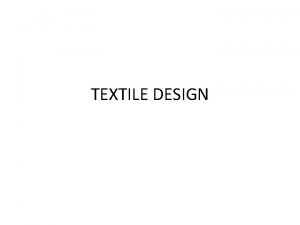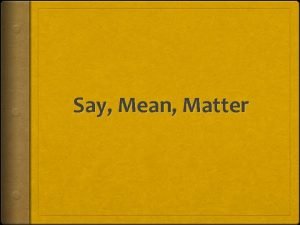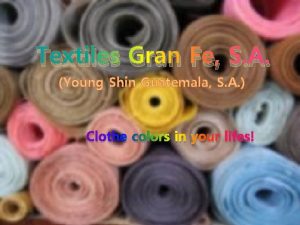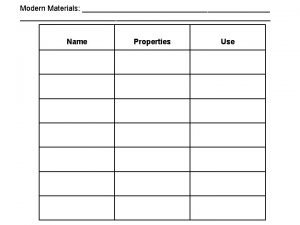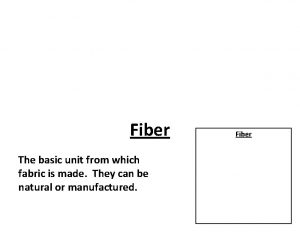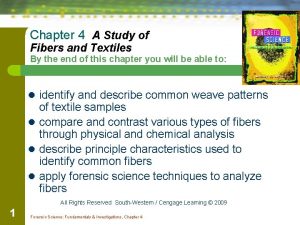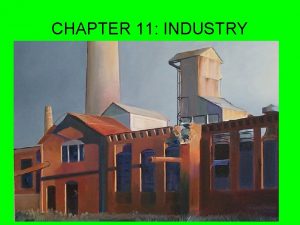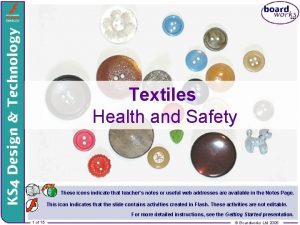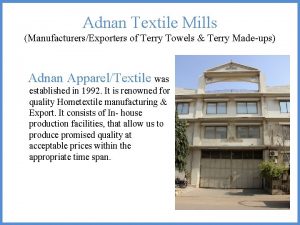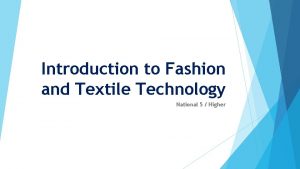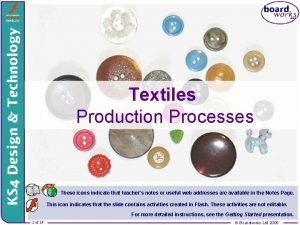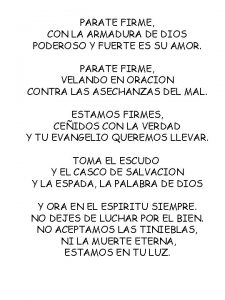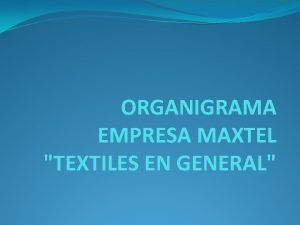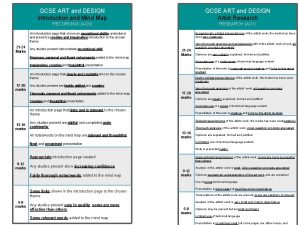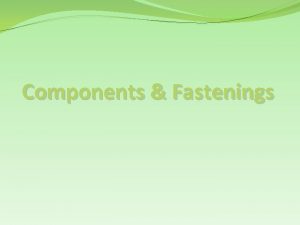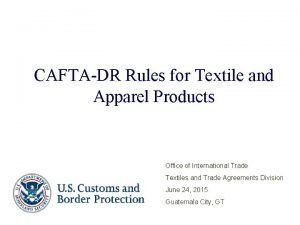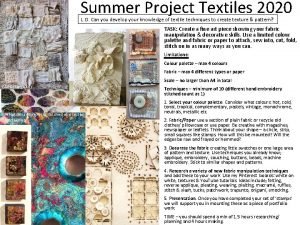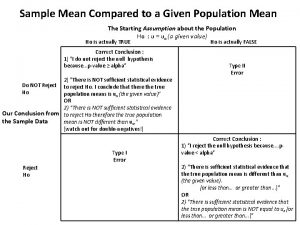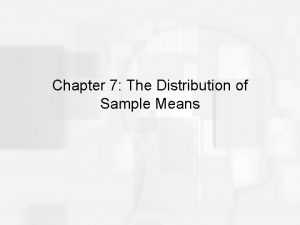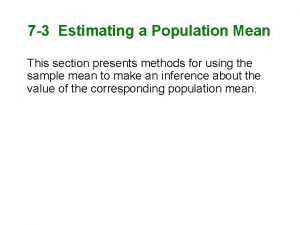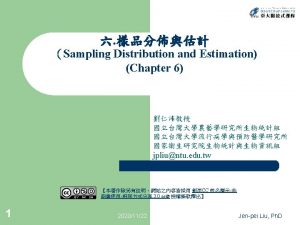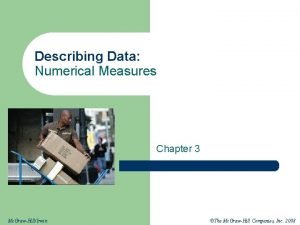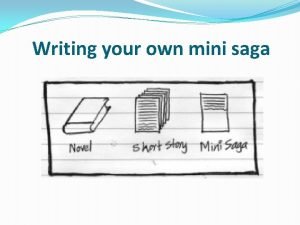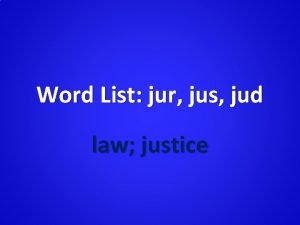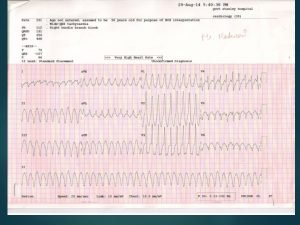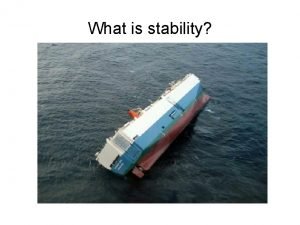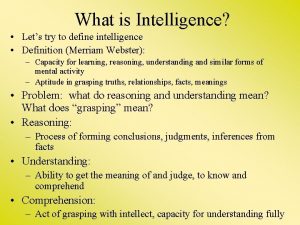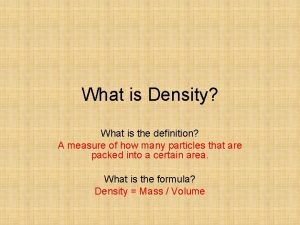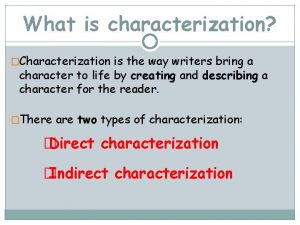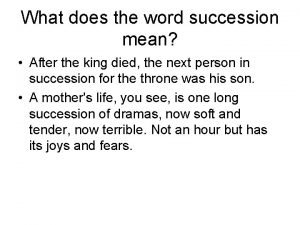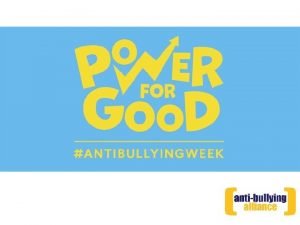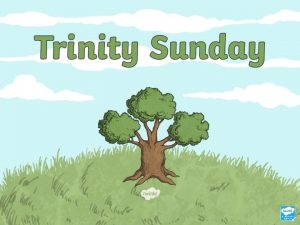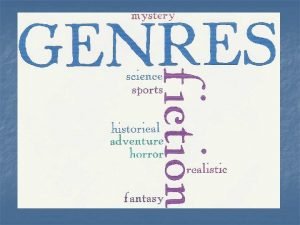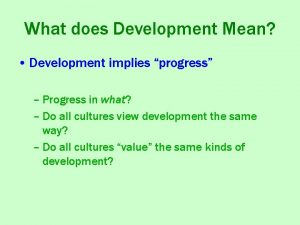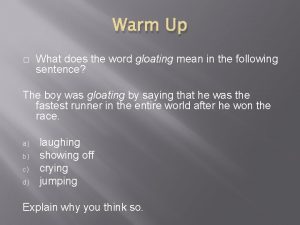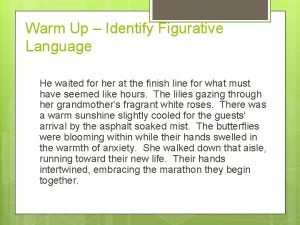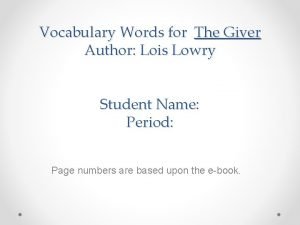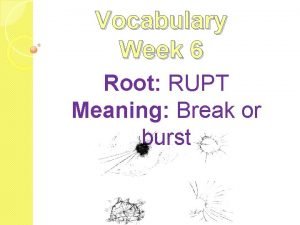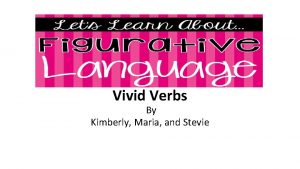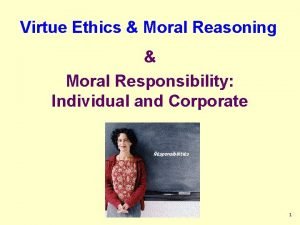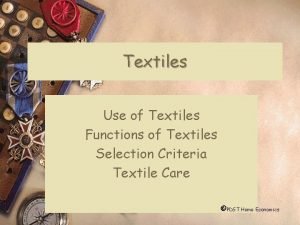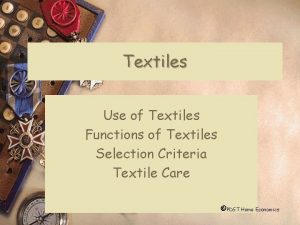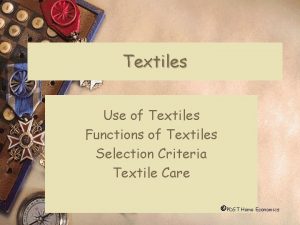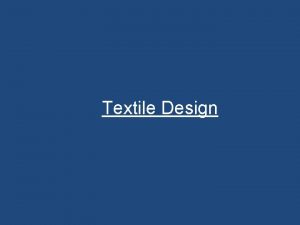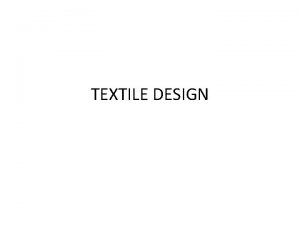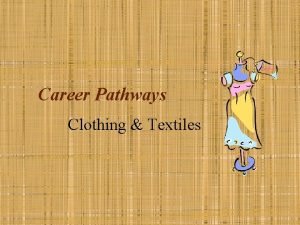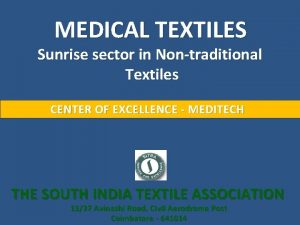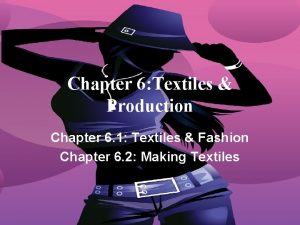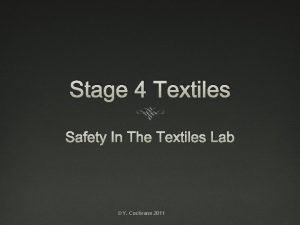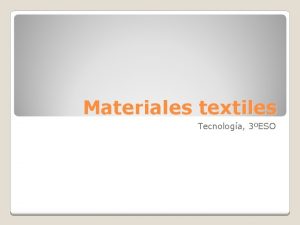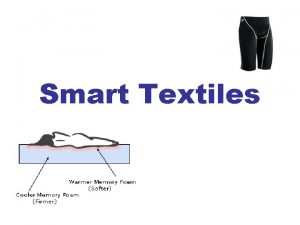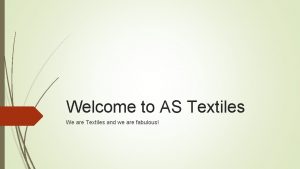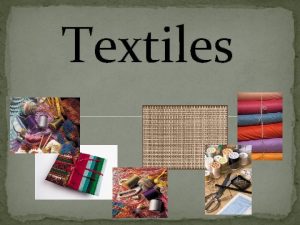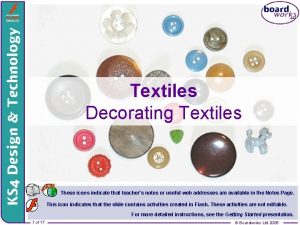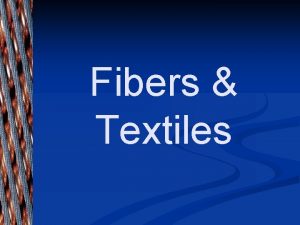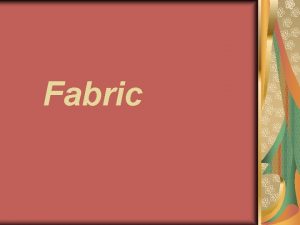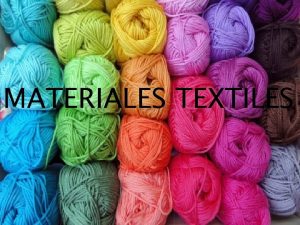TEXTILES 1 What Does Textile Mean A textile
























































- Slides: 56

TEXTILES! 1

What Does “Textile” Mean? A textile is a cloth or other good (item) produced by weaving, knitting, or felting. Thread, fiber, and yarn are textiles, too. The ‘textile industry’ is the production of cloth, knits, and yarn items. 2

Natural and Synthetic Fibers Textiles are made from natural and synthetic yarns and threads. Yarns and threads are made from fibers. Fibers come from both natural and synthetic sources. Natural wool fibers being sheared from a sheep to be spun into yarn or thread. 3

NATURAL FIBERS: WOOL Sheep are sheared with scissors or electric clippers to get their wool. 4

NATURAL FIBERS: WOOL The wool is then washed 5

NATURAL FIBERS: WOOL The wool is ‘carded’ to separate the fibers 6

NATURAL FIBERS: WOOL The wool is spun into ‘hanks’ to knit or weave. Thicker hanks turn into yarn for knitting and crocheting. 7

NATURAL FIBERS: COTTON Cotton is picked by hand or machine 8

NATURAL FIBERS: COTTON Cotton is baled for sale. At the factory it is made into thread by a Cotton Gin. 9

NATURAL FIBERS: COTTON The cotton is dyed and woven into cloth. It is then wound onto cardboard bolts to send to the fabric store. Bolts of fabric for sale by the yard 10

NATURAL FIBERS: SILK Silk is soft, shiny, and breathable. The only way to get silk is to kill the worm when he is all wrapped up in his cocoon! His cocoon is boiled to get the silk fibers to be used to weave silk cloth. 11

NATURAL FIBERS: SILK Because of the process to make silk cloth, it is expensive. Silk is used in dresses, blouses, shirts, and lingerie (night gowns and underwear). Because it is a natural fiber, it breathes and feels good against your skin. Silk fibers are not smooth so silk cloth often has ‘nubs. ’ 12

NATURAL FIBERS: LINEN Linen comes from the Flax plant. It wicks water and does not feel wet so it is worn in hot, humid climates. Linen does not grow bacteria, so it is very nice for kitchen towels. FLAX 13

NATURAL FIBERS: LINEN Flax is carded, spun, and prepared for being woven into cloth 14

NATURAL FIBERS: LINEN Linen is very wrinkly because it is made from plant fiber. It is very comfortable in hot, sweaty climates – perfect for a safari! We still call sheets, towels, and blankets, “Linens” because fine sheets and towels were once made with Linen! 15

NATURAL FIBERS: BAMBOO Bamboo is stripped into pieces, crushed into pulp, and made into fibers which are combed (carded) into thread or yarn. It can be knitted or woven into cloth for socks, garments, and even blankets. 16

SYNTHETIC FIBERS: RAYON Rayon is made from cellulose fibers from wood and cotton linters (silky fibers on the cotton plant). Rayon is stronger than wool but weaker than cotton, linen, or silk. Rayon wrinkles easily and shrinks easily. 17

SYNTHETIC FIBERS: POLYESTER Polyester is made from a chemical formula. It is extremely strong and resilient (strong and stretchy). It does not wrinkle, shrink, or fade. It can be woven or knit into garments, car seat covers, coats, and blankets – almost anything! 18

Synthetic Blends Sometimes, the best fabric (textile) is a blend of a synthetic and a natural fiber, like Cotton and Polyester. 19

Yarns (thicker than thread) are knitted, crocheted, and felted. Threads are woven or knit into woven and knit fabrics, or cloth. Both knit and woven “goods” (textiles) are important for us to understand learn about. YARNS AND THREADS Bolts of fabric arranged by fiber content and color 20

Woven Cloth Weaving can be done by hand or machine. Most cloth is now made on giant looms with automatic features to change threads, weave in patterns, and wind the finished textile onto cardboard bolts. 21

This woman can make cloth on her loom for she and her daughters to cut and sew into garments. Note the shuttle in her hand. L O O M A N D S H U T T L E 22

Fabric is made with spools of thread. In the old days, thread spools were changed and arranged by hand. Mechanical Loom and Shuttle 23

Industrial-size loom. People are still needed to change threads, color-match dye lots, and inspect the product. 24

WEAVING TERMS The “weft” is the crosswise thread. The “warp” is the lengthwise thread. On most cloth, the weft has a bit of ‘give, ’ or stretch due to the weaving pattern. 25

Simple Weaving A simple weave pattern uses one thread in the following pattern: Under one, over one, under one, over one. This creates a basic woven pattern that is strong and useful. Patterns and designs are often stamped onto simple woven cloth to create designs. 26

Patterns of Weaving: Basket Weave (two threads together) 27

Patterns of Weaving: Twill Weave Offset crossing of warp and weft in a diagonal pattern for strength! Twill is famous because denim jeans are twill! 28

Denim is twill. Twill is VERY strong. That’s why we use is for work clothes and play clothes. 29

Twill Means Strength and Comfort 30

Girls in Denim 31

Twill: Chino lighter yarn means lighter fabric 32

Woven Gingham Quality gingham fabric has the design woven into the cloth. Colored threads and white threads, woven in a pattern of alternating stripes, create the checkered pattern. Poor quality gingham is simply a stamped pattern; look at the back to tell! 33

Stamp Printing Designs can be stamped onto fabric by hand or by machine. These designs were stamped with a fork, a pencil eraser, and carved-cork shapes with fabric paint! 34

Stamp Printing This all-over design is stamped by machine onto a solid white fabric. 35

Batik Printing Batik prints are made with wax, cloth, and dye. Wax is applied with a Canting tool to the areas which the artist wishes to leave free of dye. 36

Batik Printing Melted wax is ‘drawn’ onto the fabric to create designs. The areas covered with wax will NOT accept dye. Often, several different coats of wax is applied with several different coats of dye. 37

Batik Printing This sample used only one dye rinse and one wax pattern. This is the simplest form of batik. 38

Corduroy: Soft but Weak 39

Looped Textiles Some cloth is made by adding ‘loops’ to the weaving process. Textiles made with loops include cordoroy, velvet, and even towels! 40

Velvet: Soft, thick, and Weak Extra fibers are woven into the cloth as loops. The loops are cut and the result is a soft, thick fabric. 41

Satin: Shiny, thin, dressy! 42

BRIDAL SATIN The shine of satin is created by fine threads strung across seven or eight threads before going under one thread! These ‘floating’ threads create shine and catch light but are VERY prone to snags and are damaged by rubbing. 43

What About Lace? Lace is not woven. It is knitted or knotted. Lace is create with patterns of knots! This illustration is a home spool for creating lace with bobbins. Because lace is timeconsuming it is expensive. Some laces are still made by hand! 44

Most lace today is made by machine in factories. Inexpensive laces are flat with overall designs. 45

Schiffli Lace Schiffli lace is embroidered onto fine netting or organza (sheer fabric). Schiffli is commonly used in formal wear, garments made of more delicate, expensive fabrics. 46

Cotton Lace Cotton laces are knotted (above) or embroidered onto cotton cloth (right). They are inexpensive. 47

Re-embroidered Lace Re-embroidered lace is expensive and used only in formal wear, primarily weddings. It can be clipped apart to create designs for neck and sleeve edges. 48

Alencon lace is the "Queen of Lace. " It is a fine quality knotted lace that is named after the city in France where lace making originated. This exquisite Alencon reembroidered lace fabric is a net backing that is decorated in a floral pattern, then reembroidered with a cord to define the flowers, and both selvages (edges) are scalloped. 49

WOVEN KNIT 50

KNIT TEXTILES (FABRIC) Instead of warp and weft threads, knits are created from one long yarn, looped into itself, loop after loop. If you accidentally put a hole in this fabric – watch out! 51

Knits: Holes Get Bigger Quickly! 52

KNIT TEXTILES (FABRIC) Fabric is made on giant knitting machines. Single knit is the most common; this is what our t-shirts are made from. Knits are nice and stretchy! These four girls are all wearing knit t-shirts! 53

All Knits Are Alike, Big and Small Knitted T-Shirt up close Knitted Yarn 54

Now you can use your knowledge of textiles to help you make fabric and clothing choices! 55

56
 Word textile
Word textile Absolute mean deviation
Absolute mean deviation What does mean mean
What does mean mean What do you mean matter
What do you mean matter Textiles gran fe
Textiles gran fe Polimeros textiles
Polimeros textiles Name the machine which is smart and modern
Name the machine which is smart and modern Vista longitudinal de la lana
Vista longitudinal de la lana Health and safety in textiles classroom
Health and safety in textiles classroom Basic unit in the construction of textiles
Basic unit in the construction of textiles What is a textile in forensic science
What is a textile in forensic science What is the primary site factor for production of textiles
What is the primary site factor for production of textiles Thermochromic textiles
Thermochromic textiles Textiles health and safety
Textiles health and safety Adnan textiles ltd
Adnan textiles ltd National 5 fashion and textiles
National 5 fashion and textiles Textiles production systems
Textiles production systems Padre santo te aprecio
Padre santo te aprecio Organigrama de una empresa de textiles
Organigrama de una empresa de textiles Mind map gcse art
Mind map gcse art Examples of fasteners in sewing
Examples of fasteners in sewing Safety precautions in electronics lab
Safety precautions in electronics lab Caftadr
Caftadr Summer textiles
Summer textiles Difference between modern and smart materials
Difference between modern and smart materials Introduction to home textiles
Introduction to home textiles Charles rennie mackintosh textile designs
Charles rennie mackintosh textile designs Difference between sample mean and population mean
Difference between sample mean and population mean Difference between mean and sample mean
Difference between mean and sample mean Example of population mean
Example of population mean Mean of the sampling distribution of the sample mean
Mean of the sampling distribution of the sample mean Define mean deviation
Define mean deviation Mini sagas meaning
Mini sagas meaning Tap the prompt
Tap the prompt What does the root jur mean?
What does the root jur mean? Wide qrs complex
Wide qrs complex What is stability
What is stability Definitions of intelligence
Definitions of intelligence Direct characterizations
Direct characterizations What does more dense mean
What does more dense mean What is characterizations
What is characterizations Secondary succession in order
Secondary succession in order What does the word bullying mean
What does the word bullying mean What does renaissance mean
What does renaissance mean What does the prefix tri mean?
What does the prefix tri mean? What is leadership mean to you
What is leadership mean to you What is an inference
What is an inference What does being blessed mean
What does being blessed mean What does it mean to be professional
What does it mean to be professional A genre is a(n)
A genre is a(n) What does this picture mean
What does this picture mean What does gloating mean
What does gloating mean Figurative language warm up
Figurative language warm up The giver page 127
The giver page 127 Root word rupt
Root word rupt What does vivid verbs mean
What does vivid verbs mean Moral duties
Moral duties
